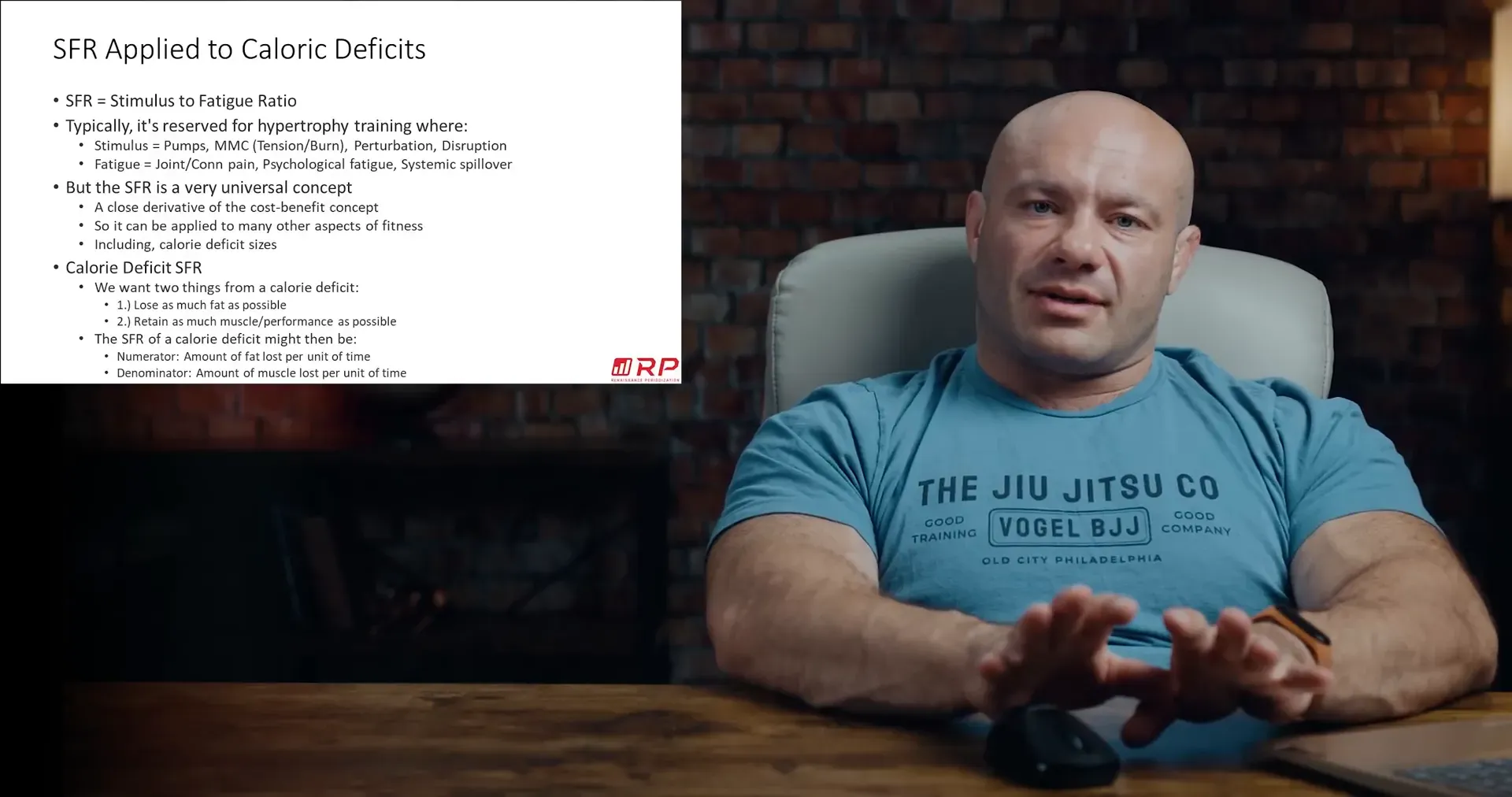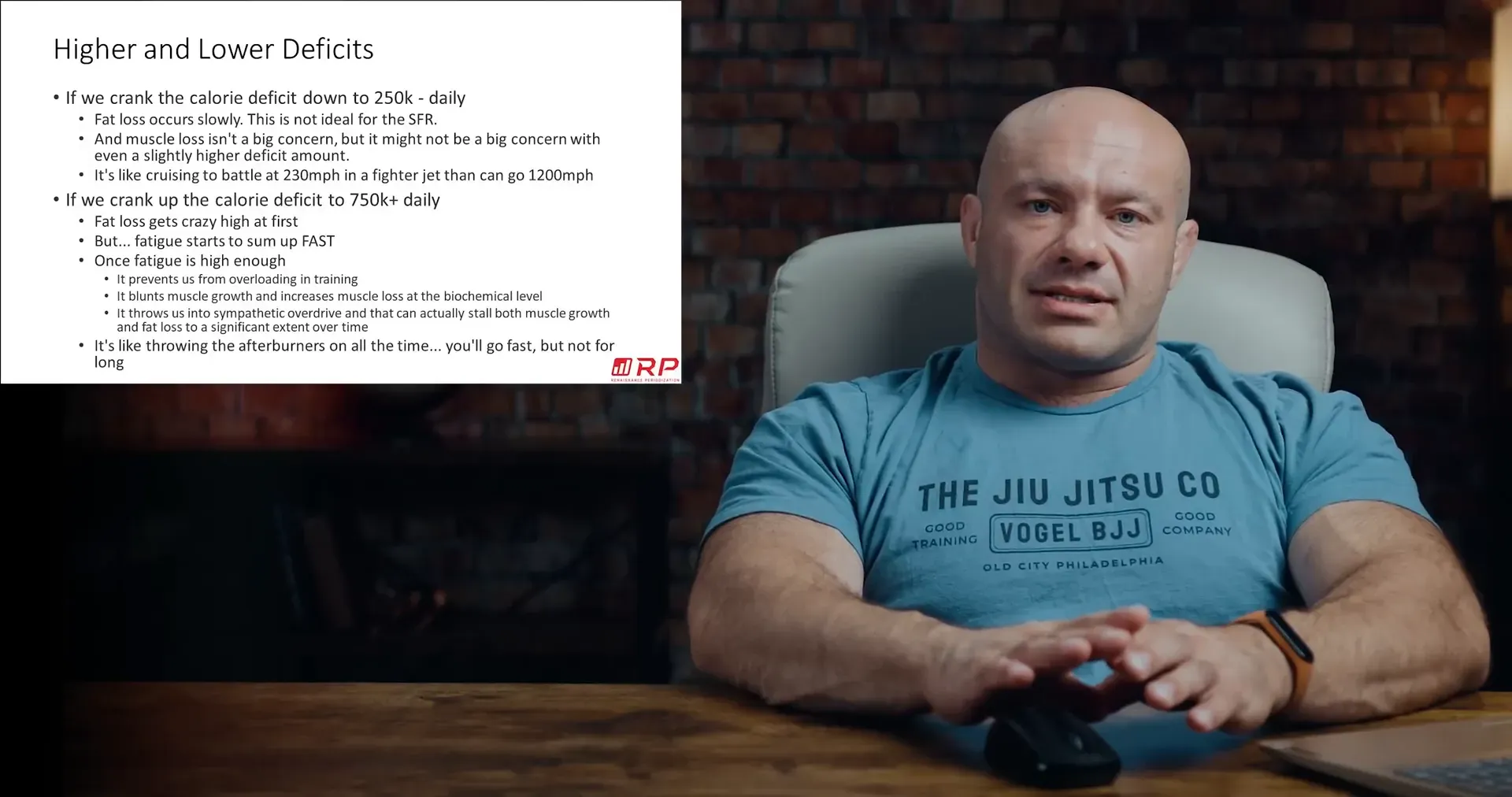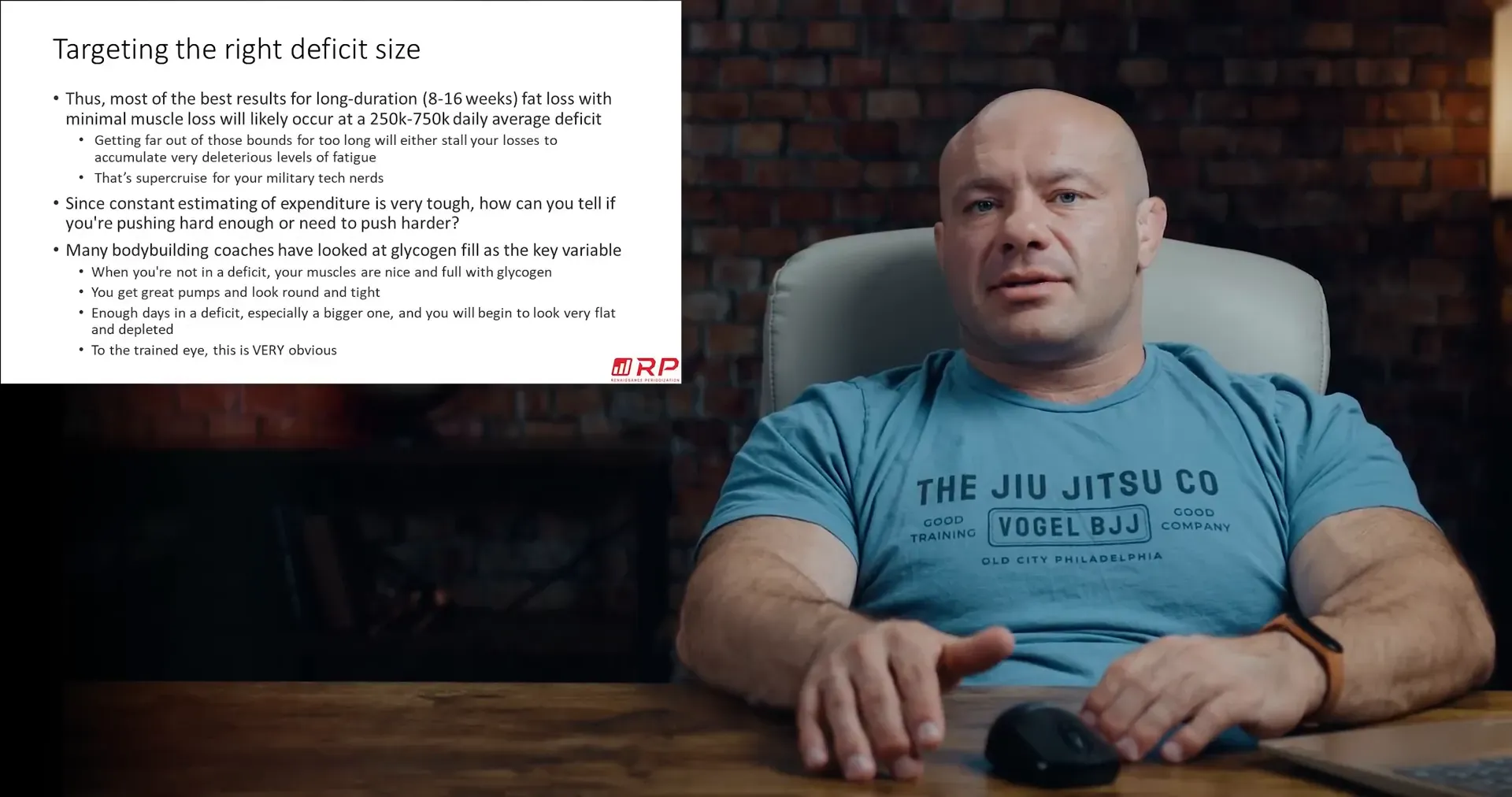Caloric Deficit for Cutting: Fat Loss Without Muscle Loss
Expert tips for losing fat without losing muscle during a cut

Key Takeaways
- Choose a 500-calorie deficit for steady fat loss without excessive muscle loss.
- Incorporate high-protein foods to preserve muscle in a caloric deficit.
- Alternate between deficit and maintenance phases to prevent burnout.
- Track body composition changes rather than just scale weight for accuracy.
- Recognize that each individual’s response varies, so adjust your plan accordingly.
Looking to cut fat while keeping your hard-earned muscle?
In this expert review, we analyze, critique, and expand on Dr. Mike Israetel's approach to achieving a caloric deficit for cutting. Our team, including an exercise scientist with over 20 years of gym experience, carefully reviews his methods to help you build a more muscular, leaner physique.
We discuss proven strategies and share little-known tips to optimize your cutting journey. You’ll learn to manage your caloric deficit to maximize fat loss while preserving muscle.
Whether you aim to get shredded or improve your physique, our step-by-step guide shows you how to achieve a more athletic, defined body through smart nutrition choices. This is more than a review—it’s a roadmap to navigating your caloric deficit for effective cutting.
Related:
- Dr. Mike Israetel on Fat Loss: Losing Weight Effectively
- Body Recomposition: Gaining Muscle & Losing fat
- How to Gain Muscle & Lose Fat: A 4-Step Process (With Meal Plan)
In a Nutshell: Caloric Deficit for Cutting
Aim for a 500-calorie deficit, prioritize protein intake to support muscle retention, and incorporate strength training into your routine for optimal results. The article also recommends periodic refeeds to restore energy and glycogen levels to avoid burnout.
This sustainable approach ensures that fat loss continues smoothly while protecting muscle mass and energy, providing a clear path to lasting, healthy results during your cutting phase.
| Key Concept | Main Insight |
|---|---|
| Optimal Deficit | A 500-calorie deficit strikes the right balance between fat loss and muscle retention. |
| Protein Priority | High protein intake supports muscle preservation during fat loss. |
| Strength Training | Essential to maintain muscle mass while in a caloric deficit. |
| Balanced Approach | Avoids extremes; promotes steady progress and minimizes muscle loss for long-term results. |
Understanding Calorie Deficits

When we create a caloric deficit, we need to consider both the fat loss and muscle preservation. A small deficit may result in slow fat loss but protects muscle. A larger deficit may speed up fat loss but increases the risk of muscle loss.
Finding the right caloric deficit means striking a balance. For many, a 500-calorie deficit per day is optimal. This level allows for steady fat loss while minimizing muscle loss.
Fat Loss vs. Muscle Loss
Understanding the difference between fat loss and muscle loss is essential. Fat loss is our primary goal in a diet. However, muscle loss can happen if we’re not careful.
Muscle loss can occur due to excessive caloric deficits. If we push too hard, our bodies may start breaking down muscle for energy. This is the opposite of what we want.
- Fat Loss: Ideally, we want to lose fat without losing muscle.
- Muscle Loss: This should be minimized to maintain strength and metabolism.
The Effects of a Small Caloric Deficit
A small caloric deficit, like 250 calories per day, may result in slow fat loss. However, it greatly reduces the risk of muscle loss. This is a safe approach, especially for those new to dieting.
With a small deficit, your body can adapt without significant stress. You’ll lose fat gradually, which is often more sustainable. Remember, slow and steady wins the race.
Thought Experiments on Caloric Deficit for Cutting

Let’s explore some scenarios. First, consider a 250-calorie deficit. You’ll lose fat, but it will take time. The risk of muscle loss is low, making it a safe choice.
Now, think about a 750-calorie deficit. You’ll see rapid fat loss, but the fatigue will build up quickly. Over time, this can lead to muscle loss and decreased performance.
- 250-Calorie Deficit: Safe, slow fat loss.
- 750-Calorie Deficit: Fast fat loss, but high risk of muscle loss.
Choosing the right deficit is crucial for long-term success. Balance is key.
High Caloric Deficits: Risks and Rewards
When it comes to dieting, high caloric deficits can seem appealing. The prospect of rapid fat loss is enticing. However, we must tread carefully.
A caloric deficit greater than 750 calories per day can lead to significant risks. Yes, you may lose weight quickly. But, the consequences can be severe.
One major risk is muscle loss. When the body is deprived of calories, it may start breaking down muscle for energy. This is counterproductive, especially for those looking to maintain strength and physique.
- Muscle Loss: A high caloric deficit can lead to muscle breakdown.
- Fatigue: Increased fatigue affects performance and recovery.
- Hormonal Imbalance: Stress hormones like cortisol can rise, while anabolic hormones like testosterone may drop.
The Biochemical Effects of Fatigue
Fatigue isn't just about feeling tired. It has biochemical implications that affect muscle growth and recovery. When you push your body too hard, it responds in ways that hinder progress.
For instance, fatigue can elevate levels of AMPK. This signaling pathway promotes catabolism over anabolism. In simple terms, it can lead to muscle loss rather than gain.
Additionally, chronic fatigue can disrupt hormonal balance. Elevated cortisol levels can lead to muscle wasting. At the same time, lower testosterone levels can hinder muscle growth.
- AMPK Activation: Promotes fat oxidation and inhibits muscle growth.
- Cortisol Increase: Associated with stress and muscle breakdown.
- Testosterone Decrease: Essential for muscle repair and growth.
The Fighter Jet Analogy
Imagine a fighter jet. It can fly at incredible speeds, but it needs to be managed wisely. If it flies too slowly, it takes forever to reach its destination. Conversely, if it flies too fast without breaks, it may burn out its engines.
The same concept applies to caloric deficits. A small deficit may seem safer, but it prolongs the process of fat loss. A high deficit accelerates fat loss but risks burnout in the form of fatigue and muscle loss.
Finding that sweet spot is crucial. You want to fly fast enough to reach your goals but not so fast that you crash and burn.
Practical Recommendations for Caloric Deficit for Cutting

So what’s the ideal caloric deficit? For many, a deficit of around 500 calories per day is optimal. This level strikes a balance between losing fat and preserving muscle.
Here are some practical recommendations:
- Monitor Your Intake: Keep a close eye on your calories and adjust as needed.
- Prioritize Protein: Ensure adequate protein intake to support muscle preservation.
- Incorporate Strength Training: Resistance training is vital to maintain muscle mass while in a deficit.
- Listen to Your Body: Adjust your caloric intake based on how you feel. If fatigue sets in, consider a refeed.
Intake for Optimal Results
Cycling your caloric intake can be an effective strategy. It allows for periods of deficit followed by refeeding. This method helps manage fatigue and maintain muscle mass.
For instance, after a week of being in a deficit, consider a few days of maintenance or a slight surplus. This helps replenish glycogen and reduce fatigue. Then, you can return to the deficit phase.
By alternating between these phases, you can achieve sustainable fat loss while minimizing muscle loss. It’s a more dynamic approach to dieting.
- Deficit Phase: 3-7 days of caloric restriction.
- Refeed Phase: 2-5 days of increased caloric intake.
- Repeat Cycle: Continue alternating to optimize results.
Long-Term Strategies for Fat Loss
To achieve lasting fat loss, you need a solid plan. Short-term diets often fail. Instead, focus on sustainable strategies that promote long-term success.
First, set realistic goals. Understand that losing fat takes time. Aim for about 1 pound per week. This pace is safe and effective.
Next, prioritize whole foods. Fill your diet with fruits, vegetables, lean proteins, and whole grains. These foods are nutrient-dense and help you feel full.
Incorporate Strength Training
Strength training is crucial for fat loss. It helps maintain muscle mass while you're in a caloric deficit. More muscle means a higher resting metabolic rate.
Include compound movements like squats, deadlifts, and bench presses. These exercises engage multiple muscle groups, maximizing calorie burn.
Aim for at least two to three strength training sessions per week. This will keep your metabolism revved up and help you retain muscle.
Stay Active Outside the Gym
Activity doesn’t stop at the gym. Incorporate movement into your daily life. Take the stairs instead of the elevator. Walk or bike instead of driving when possible.
Consider tracking your steps. Aim for at least 10,000 steps a day. This simple adjustment can significantly increase your daily energy expenditure.
Manage Stress and Sleep
Stress and lack of sleep can hinder fat loss. High stress raises cortisol levels, leading to fat storage, especially around the belly. Prioritize stress management techniques.
Practice mindfulness, meditation, or yoga. These activities can help lower stress levels. Additionally, aim for 7-9 hours of quality sleep each night.
Track Progress and Adjust
Monitoring your progress is essential. Use a journal or an app to log your food intake, workouts, and body measurements. This helps you stay accountable.
Regularly assess your results. If you hit a plateau, don’t panic. Adjust your caloric intake or change your workout routine to reignite progress.
Avoiding Common Pitfalls in Dieting
Many people fall into traps when dieting. Recognizing these pitfalls can help you stay on track.
Extreme Caloric Deficits
One major mistake is adopting extreme caloric deficits. While it may seem effective for fast weight loss, it often leads to muscle loss and metabolic slowdown.
Stick to a moderate deficit. Aiming for about 500 calories less than your maintenance level is ideal. This approach promotes fat loss while preserving muscle.
Overemphasis on Cardio
Another common pitfall is overdoing cardio. While cardio is beneficial, excessive amounts can lead to muscle loss. Balance cardio with strength training for optimal results.
Incorporate both aerobic and anaerobic exercises. This combination will help you burn fat while maintaining muscle mass.
Neglecting Nutrition
Many dieters focus solely on calories, neglecting the quality of their food. Prioritize nutrient-dense foods over processed options. Quality matters just as much as quantity.
Additionally, don’t skip meals. This can lead to binge eating later. Instead, eat regular, balanced meals to keep your metabolism steady.
Falling for Fad Diets
Fad diets promise quick results but often fail in the long run. They can be unsustainable and may lead to yo-yo dieting. Focus on a balanced diet that you can maintain.
Educate yourself about nutrition. Understand the principles of a healthy diet rather than following trends. This knowledge will empower your choices.
Guidelines for Optimal Cutting:
- Start with a moderate caloric deficit cutting around 500 calories daily to achieve fat loss while preserving muscle.
- Prioritize a protein intake of 1.6-2.2 grams per kilogram of body weight to support muscle retention during your cutting phase.
- Incorporate strength training at least 2-3 times weekly, focusing on compound movements like squats, deadlifts, and presses for maximum muscle preservation.
- Schedule refeed days every 1-2 weeks, increasing carbohydrates to replenish glycogen and reduce fatigue, helping you stay energized while cutting.
- Track your body composition regularly to assess fat loss and muscle maintenance accurately rather than relying on scale weight.
- Aim for 7-9 hours of quality sleep per night to support recovery and minimize muscle loss during a caloric deficit for cutting.
Examples:
- For someone aiming to cut fat, a 500-calorie deficit combined with 150 grams of protein daily and three strength sessions per week can yield steady progress.
- If fatigue sets in, try a refeed day with an additional 100-150 grams of carbs to restore energy and maintain workout intensity while in a caloric deficit.
Fact-Check of Key Points
- 500-Calorie Deficit as Optimal: Suggesting a 500-calorie deficit as optimal for caloric deficit cutting is helpful but not universally applicable.
- Risk of Muscle Loss with Larger Deficits: The article accurately highlights the risk of muscle loss with larger deficits. However, some individuals may successfully handle a slightly larger deficit with proper muscle preservation strategies—such as adequate protein intake and strength training. Maintaining muscle while in a caloric deficit for cutting is essential for optimal results.
- Importance of Refeed Days and Caloric Cycling: Refeed days are recommended to help manage glycogen and energy, especially for those practicing caloric cycling. This approach can support energy levels and aid in maintaining adherence to a deficit. However, frequent refeeds aren’t necessary for everyone; their effectiveness may vary based on individual goals and responses during the cutting phase.
- Fatigue and Hormonal Imbalance: The article connects high deficits with fatigue and potential hormonal shifts, which can occur with prolonged calorie restriction. However, with a balanced caloric intake for cutting, short periods of more significant deficits may not severely impact energy or hormones if managed adequately with rest and nutrition.
Science of Caloric Deficit for Cutting
Research consistently supports caloric deficit as an effective method for fat reduction during weight loss, or "cutting," especially when coupled with specific dietary and exercise strategies. Meta-analyses show that caloric deficit, whether achieved through diet or exercise, reduces body weight and fat mass. However, responses vary based on factors like diet adherence, exercise, and individual metabolic adaptations.
Key Findings from Meta-Analyses
- Fat Loss and Visceral Fat Reduction: Meta-analyses reveal that both diet-induced and exercise-induced caloric deficits significantly reduce visceral fat. Exercise shows a dose-dependent response, meaning more exercise correlates with more fat reduction. However, diet-induced deficits alone do not show an apparent dose-response effect.
- Diet Composition and Performance: During caloric restriction, maintaining a high-carbohydrate diet helps preserve anaerobic performance in athletes compared to a regular carbohydrate diet, which can reduce power output (Mcmurray et al., 1991).
- Long-Term Adherence and Fat Distribution: Studies suggest that a moderate caloric deficit paired with exercise yields better adherence and stable weight loss. Caloric restriction, alone or with exercise, also significantly reduces whole-body and abdominal fat, although changes in body fat distribution might vary with individual adherence (Redman et al., 2007) and (Del Corral et al., 2009).
- Adaptive Thermogenesis: Caloric restriction triggers adaptive thermogenesis, a metabolic adaptation that reduces energy expenditure and can limit weight loss. This effect is observed in the early stages of dieting and might explain the slower-than-expected rate of weight loss in some individuals (Heinitz et al., 2020).
- Hormonal Responses: Caloric deficit influences hormones like leptin and IGF-1, with caloric restriction decreasing leptin levels and reducing IGF-1. Both are linked to fat metabolism and satiety. These hormonal adaptations can influence the persistence of energy balance and weight loss (Wadden et al., 1998).
Practical Applications
- Adherence to Moderate Deficits: Aiming for moderate caloric deficits can improve adherence and sustain fat loss over time. Rapid or extreme deficits may hinder adherence and result in quicker weight regain.
- Diet Composition: A higher carbohydrate intake may help sustain exercise performance for those in a caloric deficit, especially for athletes or individuals engaged in high-intensity workouts.
- Incorporating Exercise: Exercise enhances fat reduction, especially visceral fat, and complements the metabolic impact of caloric restriction. This combined approach is particularly beneficial for long-term body composition improvement.
Scientific Conclusion
Meta-analytic evidence underscores caloric deficit as effective for fat reduction, with combined diet and exercise strategies offering the best outcomes for body composition and fat distribution. Adaptive thermogenesis and hormonal changes can impact weight loss efficiency, suggesting individualized approaches for optimal results.
More Little-Known Tips for Maximizing Cut
- Begin Your Day with Protein: A high-protein breakfast can help curb hunger and support muscle preservation throughout the day. Aim for 20-30 grams of protein in your first meal to kickstart fat loss and keep cravings in check.
- Stay Hydrated to Control Hunger: Thirst is often mistaken for hunger. Drinking water consistently can help manage your appetite, support your fat loss goals, and make it easier to maintain your caloric deficit.
- Opt for Low-Calorie, High-Volume Foods: Choose foods that are low in calories but high in volume, like leafy greens, cucumbers, and berries. These keep you full without significantly impacting your caloric intake, making it easier to stick to your deficit.
- Increase Fiber for Lasting Fullness: Fiber-rich foods like oats, vegetables, and legumes not only aid digestion but also help keep you feeling satisfied. Adding fiber makes it easier to adhere to a caloric deficit by extending feelings of fullness after meals.
- Try Caloric Cycling for Flexibility: If a strict caloric deficit feels tough every day, consider caloric cycling. Alternating between slightly higher and lower calorie days can help you make steady progress while reducing mental and physical fatigue, giving you flexibility to stay on track.
My Opinion on Modern Diet Culture
I've come to believe that the current approach to fat loss in the fitness industry is fundamentally broken. While I respect the basic science of energy balance, my analysis suggests we're too focused on short-term results at the expense of long-term health and sustainability. I've observed this mindset creating a destructive cycle of extreme dieting followed by inevitable rebounds.
I challenge the popular belief that willpower and discipline are the primary factors in successful fat loss. In my experience, the psychological impact of aggressive deficits is severely underestimated by most fitness professionals. While others might argue that mental toughness conquers all, I believe this dangerously oversimplifies the complex relationship between psychology and physiology. The research consistently shows that sustainable approaches lead to better long-term outcomes.
Having worked with numerous clients and studied countless research papers, I'm convinced that the most successful transformations come from moderate approaches that prioritize adherence over speed. While this might not be as exciting as promising rapid results, I stand firmly behind the evidence showing that sustainable deficits around 500 calories produce superior long-term outcomes. Sometimes the boring approach is the best approach, even if that's not what sells magazine covers.
The Smart Path to Fat Loss
The science is clear: a strategic 500-calorie deficit represents the optimal approach for sustainable fat loss while maintaining valuable muscle mass. This moderate deficit, combined with proper protein intake and consistent strength training, creates an ideal environment for steady progress without the metabolic disruption and muscle loss associated with more aggressive approaches. The key is finding the right balance between stimulus and fatigue.
Success in fat loss requires more than just counting calories - it demands intelligent implementation of evidence-based strategies like protein optimization (1.6-2.2g/kg bodyweight), regular strength training, and strategic refeed periods. By following these guidelines, you can achieve your body composition goals while maintaining energy levels and gym performance. The research shows this moderate approach typically results in about one pound of fat loss per week - a sustainable rate that minimizes muscle loss.
For those looking to optimize their fat loss journey, the Dr. Muscle app automates these scientifically-proven strategies, taking the guesswork out of the equation. The app's intelligent algorithms adjust your program based on your individual response and progress, ensuring you stay in that sweet spot for fat loss while preserving muscle mass. Experience the power of automated, science-based fat loss programming with a free trial today.
FAQ
How much weight can I expect to lose in a week?
Generally, aiming for 1 pound per week is safe and sustainable. This corresponds to a caloric deficit of about 500 calories per day.
Is it okay to have cheat meals?
Yes, cheat meals can be part of a balanced diet. They can help satisfy cravings and make dieting more enjoyable. Just be mindful of portion sizes.
What should I do if I hit a plateau?
If you hit a plateau, reassess your diet and exercise routine. Consider adjusting your caloric intake or changing your workout to stimulate progress.
Can I lose fat without exercising?
While exercise is beneficial, it is possible to lose fat through diet alone. However, combining diet with exercise will yield better results and improve overall health.
How important is protein in a fat loss diet?
Protein is crucial for preserving muscle mass during fat loss. Aim for a protein-rich diet to support your body while in a caloric deficit.

